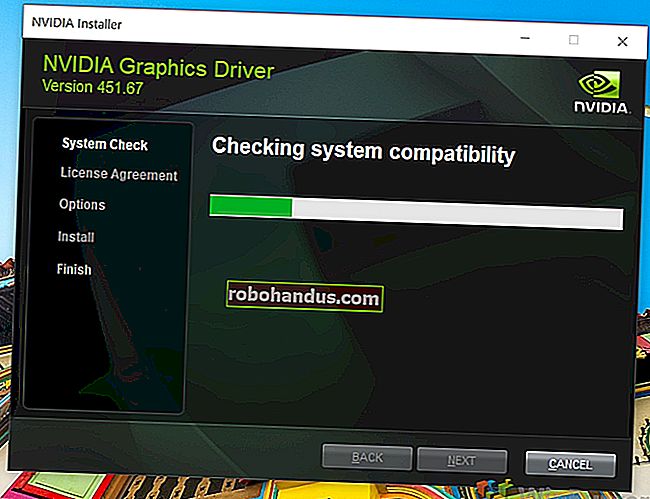Cara Menggunakan netstat di Linux

netstatPerintah Linux memberi anda banyak maklumat mengenai sambungan rangkaian anda, port yang sedang digunakan, dan proses menggunakannya. Ketahui cara menggunakannya.
Pelabuhan, Proses, dan Protokol
Soket rangkaian boleh disambungkan atau menunggu sambungan. Sambungan menggunakan protokol rangkaian seperti Transport Control Protocol (TCP) atau User Datagram Protocol UDP. Mereka menggunakan alamat Protokol Internet dan port rangkaian untuk membuat sambungan.
Soket kata mungkin menghasilkan gambar titik sambungan fizikal untuk plumbum atau kabel, tetapi dalam konteks ini, soket adalah konstruk perisian yang digunakan untuk menangani salah satu hujung sambungan data rangkaian.
Soket mempunyai dua keadaan utama: Mereka dihubungkan dan memfasilitasi komunikasi rangkaian yang sedang berlangsung, atau mereka sedang menunggu sambungan masuk untuk menghubungkannya. Terdapat keadaan lain, seperti keadaan ketika soket berada di tengah jalan untuk membuat sambungan pada peranti jarak jauh, tetapi dengan mengesampingkan keadaan sementara, anda boleh menganggap soket sama ada disambungkan atau menunggu (yang sering disebut mendengar ).
Soket mendengar dipanggil pelayan , dan soket yang meminta sambungan dengan soket pendengaran disebut pelanggan . Nama-nama ini tidak ada kaitan dengan peranan perkakasan atau komputer. Mereka hanya menentukan peranan setiap soket di setiap hujung sambungan.
The netstatarahan membolehkan anda mendapatkan yang soket disambungkan dan yang soket mendengar. Maksudnya, ia memberitahu anda port mana yang digunakan dan proses mana yang menggunakannya. Ia dapat menunjukkan jadual penghalaan dan statistik mengenai antara muka rangkaian dan sambungan multicast anda.
Fungsi netstattelah direplikasi dari masa ke masa dalam utiliti Linux yang berbeza, seperti ip dan ss. Masih bernilai mengetahui datuk ini dari semua arahan analisis rangkaian, kerana tersedia di semua sistem operasi seperti Linux dan Unix, dan juga pada Windows dan Mac.
Inilah cara menggunakannya, lengkap dengan arahan contoh.
Menyenaraikan Semua Soket
Pilihan -a(semua) membuat netstatmenunjukkan semua soket yang bersambung dan menunggu. Perintah ini mungkin menghasilkan senarai panjang, jadi kami memasukkannya less.
netstat -a | kurang

Penyenaraian itu merangkumi soket TCP (IP), TCP6 (IPv6), dan UDP.

Lekapan di tetingkap terminal menjadikannya sedikit sukar untuk melihat apa yang sedang berlaku. Berikut adalah beberapa bahagian dari penyenaraian itu:
Sambungan Internet aktif (pelayan dan dibuat) Proto Recv-Q Send-Q Alamat Tempatan Alamat Asing Negeri tcp 0 0 localhost: domain 0.0.0.0:* DAFTAR tcp 0 0 0.0.0.0:ssh 0.0.0.0:* DAFTAR tcp 0 0 localhost : ipp 0.0.0.0:* DAFTAR tcp 0 0 localhost: smtp 0.0.0.0:* DAFTAR tcp6 0 0 [::]: ssh [::]: * DAFTAR tcp6 0 0 ip6-localhost: ipp [::]: * DAFTAR. . . Soket domain UNIX aktif (pelayan dan ditubuhkan) Proto RefCnt Flags Type State I-Node Path unix 24 [] DGRAM 12831 / run / systemd / jurnal / dev-log unix 2 [ACC] STREAM LISTENING 24747 @ / tmp / dbus-zH6clYmvw8 unix 2 [] DGRAM 26372 / run / user / 1000 / systemd / notify unix 2 [] DGRAM 23382 / run / user / 121 / systemd / notify unix 2 [ACC] SEQPACKET DAFTAR 12839 / run / udev / control
Bahagian "Internet Aktif" menyenaraikan sambungan luaran yang disambungkan dan soket tempatan yang mendengarkan permintaan sambungan jauh. Iaitu, menyenaraikan sambungan rangkaian yang (atau akan) dibuat ke peranti luaran.
Bahagian "UNIX domain" menyenaraikan hubungan dalaman yang bersambung dan mendengar. Dengan kata lain, ia menyenaraikan hubungan yang telah dibuat di dalam komputer anda antara aplikasi, proses, dan elemen sistem operasi yang berlainan.
Lajur "Internet Aktif" adalah:
- Proto: Protokol yang digunakan oleh soket ini (contohnya, TCP atau UDP).
- Recv-Q: Antrian penerimaan. Ini adalah bait masuk yang telah diterima dan disangga, menunggu proses tempatan yang menggunakan sambungan ini untuk membaca dan memakannya.
- Send-Q: Antrian hantar. Ini menunjukkan bait yang siap dihantar dari barisan hantaran.
- Alamat tempatan: Maklumat alamat akhir sambungan tempatan. Lalai adalah untuk
netstatmenunjukkan nama host tempatan untuk alamat, dan nama perkhidmatan untuk port. - Alamat asing: Alamat dan nombor port di hujung jauh sambungan.
- Nyatakan: Keadaan soket tempatan. Untuk soket UDP, ini biasanya kosong. Lihat jadual negeri , di bawah.
Untuk sambungan TCP, nilai keadaan boleh menjadi salah satu daripada yang berikut:
- DAFTAR: Sisi pelayan sahaja. Soket sedang menunggu permintaan sambungan.
- SYN-SENT: Pelanggan sahaja. Soket ini telah membuat permintaan sambungan dan sedang menunggu untuk melihat apakah ia akan diterima.
- DITERIMA SYN: Sisi pelayan sahaja. Soket ini menunggu pengakuan sambungan setelah menerima permintaan sambungan.
- DITUBUHKAN: Pelayan dan pelanggan. Sambungan berfungsi telah terjalin antara pelayan dan klien, yang memungkinkan data dipindahkan di antara keduanya.
- FIN-WAIT-1: Pelayan dan pelanggan. Soket ini sedang menunggu permintaan penamatan sambungan dari soket jauh, atau untuk pengakuan permintaan penamatan sambungan yang sebelumnya dikirim dari soket ini.
- FIN-WAIT-2: Pelayan dan pelanggan. Soket ini sedang menunggu permintaan penamatan sambungan dari soket jauh.
- TUTUP-TUNGGU: Pelayan dan pelanggan. Soket ini sedang menunggu permintaan penamatan sambungan dari pengguna tempatan.
- PENUTUP: Pelayan dan pelanggan. Soket ini sedang menunggu pengakuan permintaan penamatan sambungan dari soket jauh.
- TERAKHIR-ACK: Pelayan dan pelanggan. Soket ini sedang menunggu pengakuan permintaan penamatan sambungan yang dihantar ke soket jauh.
- WAKTU WAKTU: Pelayan dan pelanggan. Soket ini mengirim pengakuan ke soket jauh untuk memberitahu bahawa ia menerima permintaan penamatan soket jauh. Sekarang menunggu untuk memastikan bahawa pengakuan telah diterima.
- TUTUP: Tidak ada sambungan, jadi soket telah ditamatkan.
Lajur "Unix domain" adalah:
- Proto: Protokol yang digunakan oleh soket ini. Ini akan menjadi "unix."
- RefCnt: Kiraan rujukan. Jumlah proses terpasang yang disambungkan ke soket ini.
- Bendera: Ini biasanya diset ke
ACC, yang mewakiliSO_ACCEPTON, yang bermaksud soket sedang menunggu permintaan sambungan.SO_WAITDATA, ditunjukkan sebagaiW, bermaksud ada data yang menunggu untuk dibaca.SO_NOSPACE, ditunjukkan sebagaiN, bermaksud tidak ada ruang untuk menulis data ke soket (iaitu, buffer kirim penuh). - Jenis: Jenis soket. Lihat jadual jenis di bawah.
- Nyatakan: Keadaan soket. Lihat jadual negeri di bawah.
- I-Node: Inode sistem fail yang berkaitan dengan soket ini.
- Laluan : Laluan sistem fail ke soket.
Jenis soket domain Unix boleh menjadi salah satu daripada yang berikut:
- DGRAM: Soket digunakan dalam mod datagram, menggunakan pesan dengan panjang tetap. Datagram tidak dijamin boleh dipercayai, disusun, dan tidak digandakan.
- STREAM: Soket ini adalah soket aliran. Ini adalah jenis sambungan soket biasa "biasa". Soket ini direka untuk memberikan penghantaran paket yang berurutan (dalam urutan).
- RAW: Soket ini digunakan sebagai soket mentah. Soket mentah beroperasi pada tahap rangkaian Model OSI dan tidak merujuk tajuk TCP dan UDP dari tahap pengangkutan.
- RDM: Soket ini terletak di salah satu hujung sambungan mesej yang boleh dipercayai.
- SEQPACKET: This socket is operating as a sequential packet socket, which is another means of providing reliable, sequenced, and unduplicated packet delivery.
- PACKET: Raw interface access socket. Packet sockets are used to receive or send raw packets at the device driver (i.e., data link layer) level of the OSI model.
The Unix domain socket state can be one of the following:
- FREE: This socket is unallocated.
- LISTENING: This socket is listening for incoming connection requests.
- CONNECTING: This socket is in the process of connecting.
- CONNECTED: A connection has been established, and the socket is able to receive and transmit data.
- DISCONNECTING: The connection is in the process of being terminated.
Wow, that’s a lot of information! Many of the netstat options refine the results in one way or another, but they don’t change the content too much. Let’s take a look.
Listing Sockets by Type
The netstat -a command can provide more information than you need to see. If you only want or need to see the TCP sockets, you can use the -t (TCP) option to restrict the display to only show TCP sockets.
netstat -at | less

The display out is greatly reduced. The few sockets that are listed are all TCP sockets.

The -u (UDP) and -x (UNIX) options behave in a similar way, restricting the results to the type of socket specified on the command line. Here’s the -u (UDP) option in use:
netstat -au | less

Only UDP sockets are listed.

Listing Sockets by State
To see the sockets that are in the listening or waiting state, use the -l (listening) option.
netstat -l | less

The sockets that are listed are those that are in the listening state.

This can be combined with the -t (TCP, -u (UDP) and -x (UNIX) options to further home in on the sockets of interest. Let’s look for listening TCP sockets:
netstat -lt | less

Now, we see only TCP listening sockets.

Network Statistics by Protocol
To see statistics for a protocol, use the -s (statistics) option and pass in the -t (TCP), -u (UDP), or -x (UNIX) options. If you just use the -s (statistics) option on its own, you’ll see statistics for all protocols. Let’s check the statistics for the TCP protocol.
netstat -st | less

A collection of statistics for the TCP connections is displayed in less.

Showing Process Names and PIDs
It can be useful to see the process ID (PID) of the process using a socket, together with the name of that process. The -p (program) option does just that. Let’s see what the PIDs and process names are for the processes using a TCP socket that is in the listening state. We use sudo to make sure we receive all of the information that is available, including any information that would normally require root permissions.
sudo netstat -p -at

Here’s that output in a formatted table:
Active Internet connections (servers and established) Proto Recv-Q Send-Q Local Address Foreign Address State PID/Program name tcp 0 0 localhost:domain 0.0.0.0:* LISTEN 6927/systemd-resolv tcp 0 0 0.0.0.0:ssh 0.0.0.0:* LISTEN 751/sshd tcp 0 0 localhost:ipp 0.0.0.0:* LISTEN 7687/cupsd tcp 0 0 localhost:smtp 0.0.0.0:* LISTEN 1176/master tcp6 0 0 [::]:ssh [::]:* LISTEN 751/sshd tcp6 0 0 ip6-localhost:ipp [::]:* LISTEN 7687/cupsd tcp6 0 0 ip6-localhost:smtp [::]:* LISTEN 1176/master
We’ve got an extra column called “PID/program name.” This column lists the PID and name of the process using each of the sockets.
Listing Numeric Addresses
Another step we can take to remove some ambiguity is to display the local and remote addresses as IP addresses instead of their resolved domain and hostnames. If we use the -n (numeric) option, the IPv4 addresses are shown in dotted-decimal format:
sudo netstat -an | less

The IP addresses are shown as numeric values. The port numbers are also shown, separated by a colon ” : ” from the IP Address.

An IP address of 127.0.0.1 shows that the socket is bound to the loopback address of the local computer. You can think of an IP address of 0.0.0.0 as meaning the “default route” for local addresses, and “any IP address” for foreign addresses. IPv6 addresses shown as “::” are also all zero addresses.
The ports that are listed can be easily checked to see what their usual purpose is:
- 22: This is the Secure Shell (SSH) listening port.
- 25: This the Simple Mail Transfer Protocol (SMTP) listening port.
- 53: This is the Domain Name System (DNS) listening port.
- 68: This is the Dynamic Host Configuration Protocol (DHCP) listening port.
- 631: This is the Common UNIX Printing System (CUPS) listening port.
RELATED:What is the Difference Between 127.0.0.1 and 0.0.0.0?
Displaying the Routing Table
The -r (route) option displays the kernel routing table.
sudo netstat -r

Here’s that output in a neat table:
Kernel IP routing table Destination Gateway Genmask Flags MSS Window irtt Iface default Vigor.router 0.0.0.0 UG 0 0 0 enp0s3 link-local 0.0.0.0 255.255.0.0 U 0 0 0 enp0s3 192.168.4.0 0.0.0.0 255.255.255.0 U 0 0 0 enp0s3
And, here’s what the columns mean:
- Destination: The destination network or destination host device (if the destination is not a network).
- Gateway: The gateway address. An asterisk “
*” appears here if a gateway address is not set. - Genmask: The subnet mask for the route.
- Flags: See the flags table, below.
- MSS: Default Maximum Segment Size for TCP connections over this route—this is the largest amount of data that can be received in one TCP segment.
- Window: The default window size for TCP connections over this route, indicating the number of packets that can be transferred and received before the receiving buffer is full. In practice, the packets are consumed by the receiving application.
- irtt: The Initial Round Trip Time. This value is referenced by the kernel to make dynamic adjustments to TCP parameters for remote connections that are slow to respond.
- Iface: The network interface from which the packets sent over this route are transmitted.
The flags value can be one of:
- U: The route is up.
- H: Target is a host and the only destination possible on this route.
- G: Use the gateway.
- R: Reinstate the route for dynamic routing.
- D: Dynamically installed by the routing daemon.
- M: Modified by the routing daemon when it received an Internet Control Message Protocol (ICMP) packet.
- A: Installed by
addrconf, the automated DNS and DHCP config file generator. - C: Cache entry.
- !: Reject route.
Finding the Port Used by a Process
If we pipe the output of netstat through grep, we can search for a process by name and identify the port it is using. We use the -a (all), -n (numeric) and -p (program) options used previously, and search for “sshd.”
sudo netstat -anp | grep "sshd"

grep finds the target string, and we see that the sshd daemon is using port 22.
Of course, we can also do this in reverse. If we search for “:22”, we can find out which process is using that port, if any.
sudo netstat -anp | grep ":22"

This time grep finds the “:22” target string, and we see that the process using this port is the sshd daemon, process ID 751.
List the Network Interfaces
The -i (interfaces) option will display a table of the network interfaces that netstat can discover.
sudo netstat -i

Here’s the output in a more legible fashion:
Kernel Interface table Iface MTU RX-OK RX-ERR RX-DRP RX-OVR TX-OK TX-ERR TX-DRP TX-OVR Flg enp0s3 1500 4520671 0 0 0 4779773 0 0 0 BMRU lo 65536 30175 0 0 0 30175 0 0 0 LRU
This is what the columns mean:
- Iface: The name of the interface. The
enp0s3interface is the network interface to the outside world, and thelointerface is the loopback interface. The loopback interface enables processes to intercommunicate within the computer using networking protocols, even if the computer is not connected to a network. - MTU: The Maximum Transmission Unit (MTU). This is the largest “packet” that can be sent. It consists of a header containing routing and protocol flags, and other metadata, plus the data that is actually being transported.
- RX-OK: The number of packets received, with no errors.
- RX-ERR: The number of packets received, with errors. We want this to be as low as possible.
- RX-DRP: The number of packets dropped (i.e., lost). We also want this to be as low as possible.
- RX-OVR: Number of packets lost due to overflows when receiving. This usually means that the receiving buffer was full and could not accept any more data, but more data was received and had to be discarded. The lower this figure, the better, and zero is perfect.
- TX-OK: The number of packets transmitted, with no errors.
- RX-ERR: The number of packets transmitted, with errors. We want this to be zero.
- RX-DRP: The number of packets dropped when transmitting. Ideally, this should be zero.
- RX-OVR: The number of packets lost due to overflows when transmitting. This usually means the send buffer was full and could not accept any more data, but more data was was ready to be transmitted and had to be discarded.
- Flg: Flags. See the flags table below.
The flags represent the following:
- B: A broadcast address is in use.
- L: This interface is a loopback device.
- M: All packets are being received (i.e., in promiscuous mode). Nothing is filtered or discarded.
- O: Address Resolution Protocol (ARP) is turned off for this interface.
- P: This is a Point-to-Point (PPP) connection.
- R: The interface is running.
- U: The interface is up.
List Multicast Group Memberships
Simply put, a multicast transmission enables a packet to be sent only once, regardless of the number of recipients. For services such as video streaming, for example, this increases the efficiency from the sender’s point of view by a tremendous amount.
The -g (groups) option makes netstat list the multicast group membership of sockets on each interface.
sudo netstat -g

The columns are quite simple:
- Interface: The name of the interface over which the socket is transmitting.
- RefCnt: The reference count, which is the number of processes attached to the socket.
- Group: The name or identifier of the multicast group.
The New Kids on the Block
The route, ip, ifconfig, and ss commands can provide a lot of what netstat is capable of showing you. They’re all great commands and worth checking out.
We’ve focused on netstat because it is universally available, regardless of which Unix-like operating system you’re working on, even the obscure ones.






